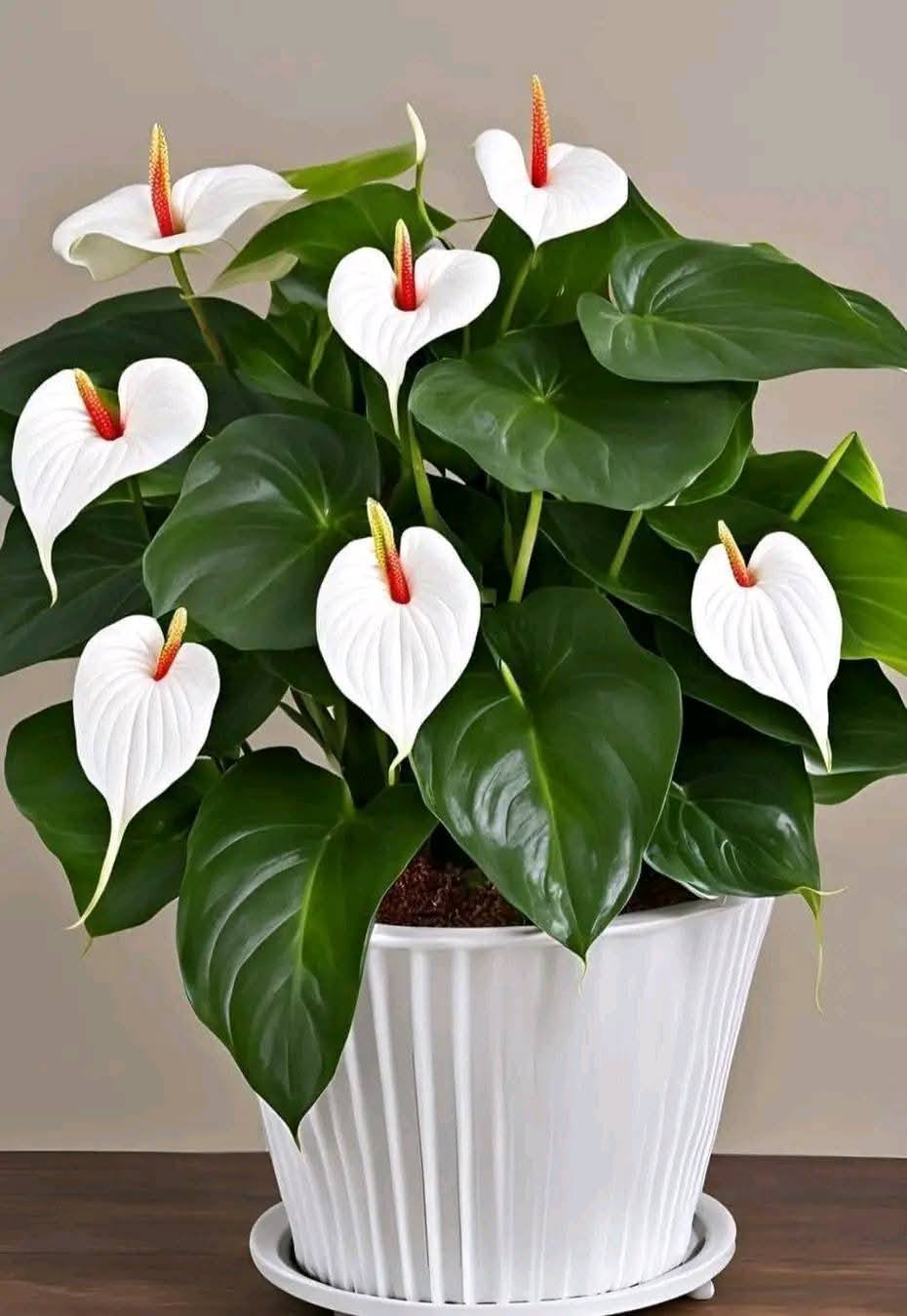Peace Lilies (Spathiphyllum) are among the most popular houseplants, known for their elegant white blooms, lush green foliage, and air-purifying qualities. These low-maintenance plants add a touch of serenity to any indoor space, making them a favorite for both beginners and experienced plant enthusiasts.
If you’re looking to cultivate a thriving Peace Lily, this step-by-step guide will help you provide the right care to keep your plant healthy and beautiful year-round.
Why Grow a Peace Lily?
- Air-Purifying Properties
Peace Lilies are among the top air-cleaning plants, known for removing toxins like formaldehyde, benzene, and carbon monoxide from indoor spaces.
- Low-Maintenance Beauty
Unlike high-maintenance plants, Peace Lilies require minimal care, making them perfect for beginners.
- Elegant Decor Element
With their deep green leaves and delicate white flowers, Peace Lilies enhance the beauty of any room, bringing in a peaceful and refreshing atmosphere.
How to Grow a Healthy Peace Lily
- Choose the Right Location
Ideal Light: Place your Peace Lily in a spot with indirect sunlight.
Avoid Direct Sun: Too much sunlight can scorch the leaves, turning them yellow or brown.
Low-Light Tolerance: Peace Lilies can survive in low-light conditions, but they may not bloom as frequently.
Best placement: Near east- or north-facing windows, where they receive gentle, filtered light.
- Select a Suitable Pot
Choose a pot with drainage holes to prevent excess moisture from sitting at the roots, which can lead to root rot.
Avoid using a pot that’s too large, as Peace Lilies prefer being slightly root-bound.
- Prepare the Perfect Soil Mix
Use a well-draining, moisture-retentive potting mix.
The best options include peat-based or loamy potting soil mixed with perlite or sand for aeration.
Avoid heavy garden soil, which can retain too much moisture and suffocate the roots.
Planting Your Peace Lily
Fill the pot about halfway with soil.
Place the Peace Lily in the center, making sure the roots are spread evenly.
Cover the roots with the remaining soil, leaving about an inch of space from the rim of the pot.
Water lightly, ensuring the soil is moist but not soggy.
Watering Your Peace Lily
Keep the soil consistently moist but not waterlogged.
Water when the top inch of soil feels dry to the touch.
Use room-temperature water, as cold water can shock the roots.
If leaves start drooping, it’s a sign your plant needs water. A good soak will revive it within a few hours.
- Humidity and Temperature Requirements
Peace Lilies thrive in higher humidity levels of 50-60%.
If the air is too dry, mist the leaves occasionally or place the plant near a humidifier.
Ideal temperature range: 65-80°F (18-27°C).
Avoid cold drafts and heating vents, as sudden temperature changes can stress the plant.
- Fertilizing for Growth and Blooms
Use a balanced, water-soluble fertilizer every 6-8 weeks during spring and summer.
Avoid over-fertilizing, as it can lead to burned leaves and reduced blooms.
During fall and winter, reduce or stop fertilizing, as the plant enters a resting phase.
What to Avoid
- Direct Sunlight
Too much sun can cause leaf burn, leading to brown or yellow patches. Keep your plant in indirect light for best results.
- Overwatering
Overwatering is the most common cause of Peace Lily problems.
If leaves turn yellow and wilt, the roots may be waterlogged.
Always check soil moisture before watering and ensure the pot has proper drainage.
- Low Humidity
Dry air can cause crispy, brown leaf edges. If your home has low humidity, mist the leaves or use a humidity tray to keep the plant happy.
Tips & Tricks for a Thriving Peace Lily
- Clean the Leaves
Dust can accumulate on leaves, blocking sunlight and affecting plant health. Wipe the leaves occasionally with a damp cloth to keep them clean and shiny.
- Repotting Your Peace Lily
Repot every 1-2 years, or when roots start outgrowing the pot.
Spring is the best time to repot. Choose a slightly larger pot and refresh the soil mix.
- Pruning and Maintenance
Remove any yellow or brown leaves to encourage new growth.
Trim spent flowers to keep the plant looking fresh and healthy.
- Toxicity Warning
Peace Lilies are toxic to pets and humans if ingested.
Keep them out of reach of cats, dogs, and small children.
If ingested, it may cause mouth irritation, nausea, or swelling.
Common Peace Lily Problems & How to Fix Them
- Why Are the Leaves Turning Yellow?
Cause: Overwatering, poor drainage, or lack of nutrients.
Solution: Check for root rot, improve drainage, and feed with a balanced fertilizer.
- Why Are the Leaves Drooping?
Cause: Underwatering or extreme temperatures.
Solution: Water the plant immediately and move it to a stable environment.
- Why Is My Peace Lily Not Blooming?
Cause: Lack of light, improper fertilization, or root-bound conditions.
Solution: Move it to a brighter spot, feed it with a phosphorus-rich fertilizer, and ensure it’s not too root-bound.
- Why Are the Leaf Tips Turning Brown?
Cause: Dry air, low humidity, or salt buildup from over-fertilization.
Solution: Increase humidity, flush the soil occasionally, and reduce fertilizer use.
Final Thoughts
Growing a Peace Lily is an easy and rewarding experience, making it a fantastic addition to any indoor space. With minimal care, proper watering, and the right environment, your Peace Lily will flourish with lush green leaves and elegant white blooms.
Transform your space with the natural beauty of Peace Lilies!
Do you have a Peace Lily at home? Share your care tips and experiences in the comments below!
More Articles You Might Like
-
Texas Toast Sloppy Joes: The Crunchy, Cheesy Upgrade You Didn’t Know You Needed
There’s something timeless about sloppy joes. For generations, this saucy, savory, and slightly sweet ground beef sandwich has been a go-to comfort food in American kitchens. It’s quick, filling, and family-friendly—perfect for busy weeknights. But what if we told you there’s a way to take this classic dish up a notch? Enter the Texas Toast…
-
Classic Pig Pickin’ Cake
When it comes to Southern desserts, few sweets shine as brightly as the Classic Pig Pickin’ Cake. This nostalgic cake, sometimes called a “Mandarin Orange Cake,” has roots deep in Southern tradition. It gets its playful name from its frequent appearance at pig pickin’s—Southern-style barbecue gatherings where communities come together to enjoy slow-cooked pork, sides,…
-
Lemon Garlic Butter Chicken with Creamy Parmesan Pasta
There’s something irresistible about the combination of tender, golden-browned chicken paired with a creamy pasta coated in Parmesan cheese. Add the brightness of lemon, the depth of garlic, and the richness of butter, and you have a recipe that feels indulgent yet approachable enough for a weeknight dinner. Lemon Garlic Butter Chicken with Creamy Parmesan…



